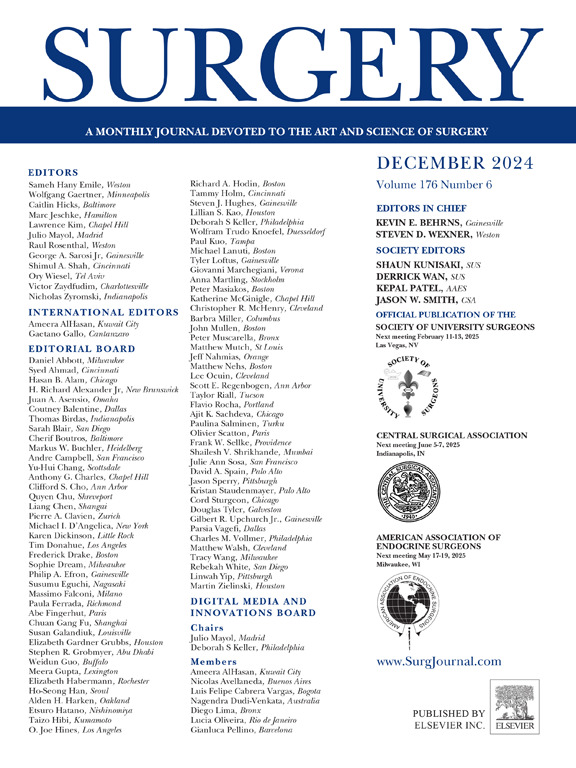创伤性肝损伤患者的肝动脉主干血管栓塞术与肝动脉节段血管栓塞术:西部创伤协会多中心研究。
IF 3.2
2区 医学
Q1 SURGERY
引用次数: 0
摘要
导言:肝血管栓塞术对血流动力学稳定的肝外伤和造影剂外渗患者的出血控制非常有效。然而,有关血管栓塞在肝动脉血管内的具体位置及其对患者预后的影响的数据却很少:方法:我们对一项跨越 23 个中心的多中心前瞻性观察研究进行了事后分析。研究纳入了在抵达后 8 小时内接受肝动脉主干血管栓塞术或肝动脉节段血管栓塞术的成人患者。主要结果是肝脏相关并发症,定义为肝周积液、胆漏/胆瘤、假性动脉瘤、肝坏死和/或肝脓肿。次要结果为肝脏相关并发症干预、住院时间和死亡率:共有55名患者接受了肝血管栓塞术,其中23人(41.8%)接受了肝动脉主干血管栓塞术,32人(58.2%)接受了肝动脉节段血管栓塞术。两组患者在年龄、生命体征、损伤机制、肝损伤分级分布和损伤严重程度评分方面均具有可比性(均P>0.05)。肝动脉主干血管栓塞组的肝脏相关并发症发生率更高(65.2% vs 31.2%,P = .039),尤其是肝周积液(26.1% vs 6.3%,P = .040)和胆漏/胆瘤(34.8% vs 12.5%,P = .048)。肝动脉主干血管栓塞术出现2种或2种以上肝脏相关并发症(47.8% vs 9.4%,P = .001)和30天内再次入院(30.4% vs 9.4%,P = .046)的比例更高。在住院时间和死亡率方面没有观察到明显差异(P均大于0.05):结论:与肝段动脉血管栓塞术相比,肝主动脉血管栓塞术与肝脏相关并发症、多种肝脏相关并发症和30天内再入院率增加有关。因此,肝主动脉血管栓塞术只有在肝段动脉血管栓塞术不可行的情况下才可使用,但发病率会显著增加。本文章由计算机程序翻译,如有差异,请以英文原文为准。
Main versus segmental hepatic artery angioembolization in patients with traumatic liver injuries: A Western Trauma Association multicenter study
Introduction
Hepatic angioembolization is highly effective for hemorrhage control in hemodynamically stable patients with traumatic liver injuries and contrast extravasation. However, there is a paucity of data regarding the specific location of angioembolization within the hepatic arterial vasculature and its implications on patient outcomes.
Methods
A post-hoc analysis of a multicenter prospective observational study across 23 centers was performed. Adult patients undergoing main hepatic artery angioembolization or segmental hepatic artery angioembolization within 8 hours of arrival were included. The primary outcome was liver-related complications, defined as perihepatic fluid collection, bile leak/biloma, pseudoaneurysm, hepatic necrosis, and/or hepatic abscess. Secondary outcomes were liver-related complication interventions, length of stay, and mortality.
Results
A total of 55 patients underwent hepatic angioembolization, with 23 (41.8%) undergoing main hepatic artery angioembolization and 32 (58.2%) receiving segmental hepatic artery angioembolization. Both groups were comparable in age, vitals, mechanism of injury, liver injury grade distribution, and injury severity score (all P > .05). The main hepatic artery angioembolization group had greater rates of overall liver-related complications (65.2% vs 31.2%, P = .039), specifically perihepatic fluid collection (26.1% vs 6.3%, P = .040) and bile-leak/biloma (34.8% vs 12.5%, P = .048). Main hepatic artery angioembolization had greater rates of 2 or more liver-related complications (47.8% vs 9.4%, P = .001) and readmission within 30 days (30.4% vs 9.4%, P = .046). No significant differences were observed in hospital length of stay and mortality (all P > .05).
Conclusions
Main hepatic artery angioembolization is associated with increased rates of liver-related complications, multiple liver-related complications, and readmission within 30 days compared with segmental hepatic artery angioembolization. Thus, main hepatic artery angioembolization should be reserved for use only when segmental hepatic artery angioembolization is not feasible, albeit with significantly increased morbidity.
求助全文
通过发布文献求助,成功后即可免费获取论文全文。
去求助
来源期刊

Surgery
医学-外科
CiteScore
5.40
自引率
5.30%
发文量
687
审稿时长
64 days
期刊介绍:
For 66 years, Surgery has published practical, authoritative information about procedures, clinical advances, and major trends shaping general surgery. Each issue features original scientific contributions and clinical reports. Peer-reviewed articles cover topics in oncology, trauma, gastrointestinal, vascular, and transplantation surgery. The journal also publishes papers from the meetings of its sponsoring societies, the Society of University Surgeons, the Central Surgical Association, and the American Association of Endocrine Surgeons.
 求助内容:
求助内容: 应助结果提醒方式:
应助结果提醒方式:


